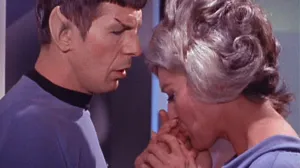Inspired by the early Teenage Mutant Ninja Turtles comics created by Kevin Eastman and Peter Laird, the 1990s film adaptation directed by Steve Barron was both a fan-favorite and a substantial financial success for New Line Cinema. The irony is that numerous larger studios turned down the chance to release it before “The House That Freddy Built” ultimately picked up the rights mid-production. At the time it was the highest-grossing independent film of all time, with $202 million worldwide (over $493 million adjusted for 2025) against a budget of just $13.5 million. However, Teenage Mutant Ninja Turtles was not free of controversy – particularly regarding its dark tone and violence. It wasn’t to the extent of 1992’s Batman Returns, but like with that film, it resulted in a toning down of problematic elements in subsequent entries.
Videos by ComicBook.com
The first film wasn’t edited very much for U.S. distribution, but it was overseas. In the UK, shots of the turtles’ weapons, e.g. Michelangelo’s nunchaku and Raphael’s sais (which were illegal in the country), were removed as was an entire fight between Michaelangelo and a member of the Foot clan. This version was used in Germany, as well, but with the added element of goofy sound effects to lessen the impact of the fight scenes.
How Did the Rest of the Franchise Adapt?

Those changes for overseas distribution are effectively what occurred for the U.S. theatrical cut of Teenage Mutant Ninja Turtles II: The Secret of the Ooze and Teenage Mutant Ninja Turtles III. In the case of The Secret of the Ooze, there was still a shot of Michelangelo’s nunchaku here and there, but to a significantly lesser degree than in the first film, where the Turtles’ weapons were used in every action sequence. And, once again, those few shots were excised from the UK cut; in the German cut, goofy sound effects were once more added.
Another noticeable change occurred with the dialogue. The first film has its fair number of quips, mostly coming from the four Turtles, but also from Judith Hoag’s April O’Neil and Elias Koteas’ Casey Jones. Yet there was also a fair amount of dialogue focused on character development, e.g. scenes like Leonardo comforting the perpetually cantankerous Raphael. In The Secret of the Ooze and the third film, most of those organic moments were nowhere to be seen or heard, replaced with more childish dialogue that only served to make the sequels a slog for critics and those parents dragged to the theater by their kids.
The result was a case of diminishing financial returns. The Secret of the Ooze made three times its budget, but that budget was nearly double what the first film’s was. Worse yet, its $78.7 million worldwide wasn’t anywhere near the original’s haul. The budget was decreased for the third movie (down to $21 million instead of $25 million), but the worldwide haul of $54.4 million was a strong indication that it was time for the Turtles movie franchise to go on hiatus.
[RELATED: Fortnite Leak Reveals Next Teenage Mutant Ninja Turtles Skins]
It would be another 14 years before the Turtles once again hit the big screen in the animated TMNT. And while that film was somewhat closer to the 1990 movie’s tone than Ooze or III, it wasn’t enough to generate much audience interest.
Enter Michael Bay after another gap, this one lasting seven years. Coming off the success of multiple Transformers movies, Teenage Mutant Ninja Turtles seemed like another opportunity ripe for nostalgic exploration. And, even if not to the degree of Transformers, it worked.
The 2014 movie, which is tonally somewhere between the 1990 movie and The Secret of the Ooze, opened stronger than most were expecting and ultimately wound up with $485 million worldwide against a budget of about $150 million. In other words, it nearly matched the adjusted worldwide haul of the original film. The difference is that the 1990 adventure had an adjusted budget of just $33 million. Compare that to $150 million and the reboot’s success looks less impressive. That said, at least it turned a profit. The same can’t be said of 2016’s Teenage Mutant Ninja Turtles: Out of the Shadows, which did the same thing the first pair of sequels did: lighten the tone. In fact, it was literally a lighter film considering the 2014 reboot had a fair portion occur at nighttime, whereas Out of the Shadows is perpetually displayed in the light of day.
Even when the series finally gained strong reviews with 2023’s animated Teenage Mutant Ninja Turtles: Mutant Mayhem (the best of the bunch by a country mile), it still didn’t generate nearly the same level of audience interest the franchise did the first time out the gate. Perhaps the lesson to be learned is that there’s an inherent cap to just how much appeal the Turtles have. Even still, for devotees of the IP, the original film has its charms for sticking so close to the source material.
The original Teenage Mutant Ninja Turtles trilogy and TMNT are available to rent on Amazon Video. The 2014 reboot, Teenage Mutant Ninja Turtles: Out of the Shadows, and Teenage Mutant Ninja Turtles: Mutant Mayhem are available to stream on Paramount+.








